Human Skeletal System
Grade 5 Science Worksheets
Imagine our bodies without bones! We will only be a blob of jelly-filled tissues! It would be impossible for us to stand, walk, or even sit! The skeletal system acts as a scaffold by providing support and protection for the soft tissues that make up our bodies. The main parts of the skeletal system are –
- Bones
- Joint
- Cartilages
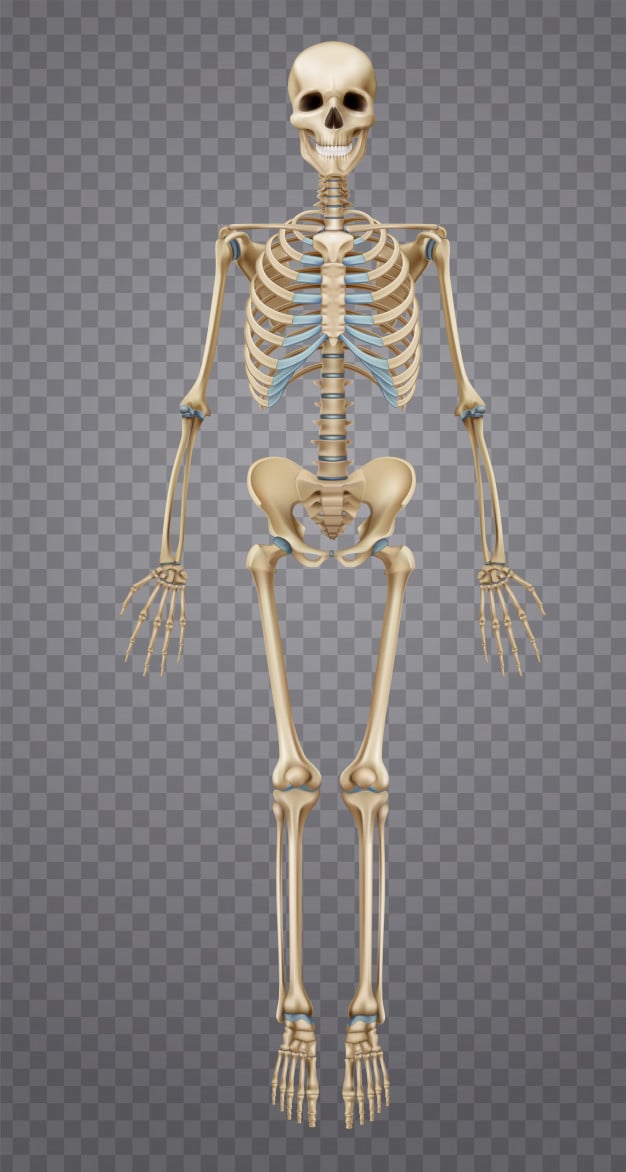
Schedule a Free session to clear worksheet doubts
No credit card required, no obligation to purchase.
Just schedule a FREE Sessions to meet a tutor and get help on any topic you want!
Bones
A bone is a rigid organ that forms a part of the vertebrate skeleton. Each bone is made up of many cells, protein fibers and minerals. They come in all sizes and shapes. The longest bone in the human body is the thighbone or the femur and the smallest in the stapes in the middle ear, which is only 3mm. More than 99% of our body’s calcium is held in our bones and teeth. A human baby is born with 300 soft bones that eventually grow together and fuse to form 206 bones in adults.
Joints
Joints are the connections between two bones. They enable movements between the bones such as elbow joints, wrist joints, hip joints, knee joints etc. Depending on their flexibility, joints are classified into various types. Some of them are as follows-
- Ball and socket joint– It permits movement in all directions. One bone has a rounded head that sits in the cup of another bone. E.g. shoulder joint, hip joint.
- Hinge joint – It is like a door and allows restricted movement in one direction. E.g. knee and elbow joint.
- Fixed joint – It allows limited or no movement. E.g. the skull.
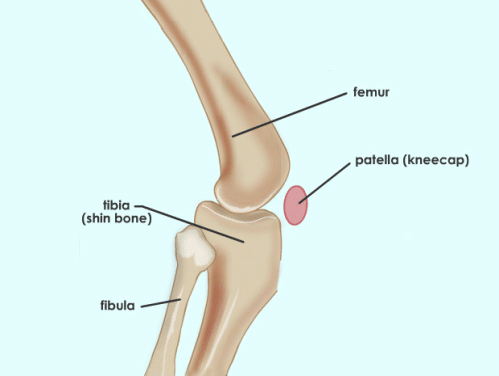
The knee joint
Cartilage
Cartilage is a firm, elastic connective tissue that gives flexibility to certain body parts. In the skeletal system, it is present in the joints providing flexibility to the bones. It is a structural component of the rib cage, the ear, the nose, the bronchial tubes and many others.
Functions of the Skeletal System
The main functions of the skeletal system are –
- Support: It gives a framework and support to our body.
- Protection: It protects the delicate internal organs such as the brain, heart, and lungs.
- Movement: It aids the movement of different body parts and the body as a whole.
- Productions of blood cells: Blood cells like RBC and WBC are produced in the bone marrow present in some bones that help in transporting oxygen and fighting infections.
- Storage of minerals: Bones are a reservoir for minerals and stores 99% of the body’s calcium and other minerals like phosphorus.
Parts of Human Skeletal System
The human skeleton is traditionally divided into two major parts:
- The Axial Skeleton
- The Appendicular Skeleton
While the axial skeleton makes up the inner framework or trunk of the body, the appedicular skeleton includes the outer limbs and the bones that connect the limbs to the center or trunk of the body.
Learn more about Human Skeletal System and other important topics with 5th Grade Science Tutoring at eTutorWorld. Our expert science tutors break down the topics through interactive one-to-one sessions. We also offer the advantage of customized lesson plans, flexible schedules and convenience of learning from home.
Personalized Online Tutoring from eTutorWorld
eTutorWorld offers affordable one-on-one live tutoring over the web for Grades K-12, Test Prep help for Standardized tests like SCAT, CogAT, MAP, SSAT, SAT, ACT, ISEE and AP. You may schedule online tutoring lessons at your personal scheduled times, all with a Money-Back Guarantee. The first one-on-one online tutoring lesson is always FREE, no purchase obligation, no credit card required.
For answers/solutions to any question or to learn concepts, take a FREE TRIAL Session.
No credit card required, no obligation to purchase.
Just schedule a FREE Sessions to meet a tutor and get help on any topic you want!
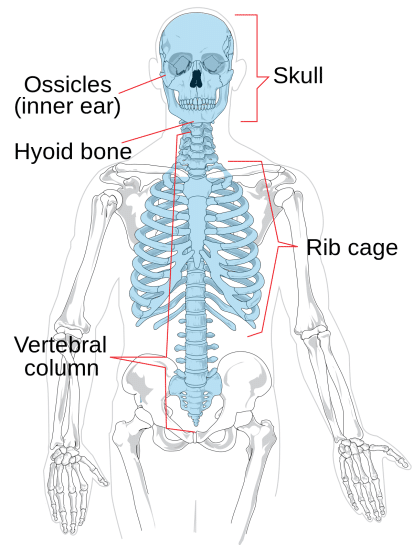
Axial Skeleton
The Axial skeleton includes the skull, middle ears, neck bone, vertebral column, chest bone, and ribs.
The bones are distributed as follows:

FUNCTIONS OF AXIAL SKELETON:
1. Skull:
The skull is a bony structure that supports the structure of the face and provides a protective cavity for the brain. The skull is composed of two parts which are the cranium that surrounds the brain and the mandible that forms the jawbone.
2. Middle ear ossicles:
They are some of the smallest bones in our body and they aid in hearing.
3. Hyoid bone in the neck:
This bone aids in tongue movement and swallowing.
4. Vertebral column:
The vertebral column is also known as the spinal column. It is the central axis of the skeleton in all vertebrates. The vertebral column provides protection to the spinal cord, nerve roots, and other organs allow muscle attachments and give structural support and balance to our body.
5. Chest bone:
Also known as the breastbone or sternum, it is shaped like a necktie and it closes the rib cage in front. It, therefore, protects the internal organs like the heart and lungs beneath it.
6. Rib cage:
The rib cage surrounds the thoracic cavity that gives protection to the chest cavity including internal organs like lungs, heart and other respiratory organs. It also supports the shoulder girdle forming a core part of the human skeleton.
Appendicular Skeleton
The appendicular skeleton is the portion of the skeleton in vertebrates that consist of the bones that support the appendages. The appendicular skeleton includes the skeletal elements within the limbs, as well as the ones that support the shoulder and the pelvic girdle. There are 126 bones in the appendicular skeleton.
Parts of Appendicular Skeleton:
The six major parts of the appendicular skeleton are as follows:
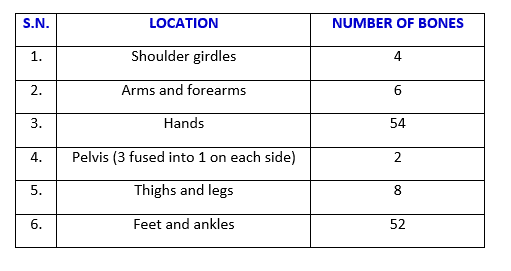
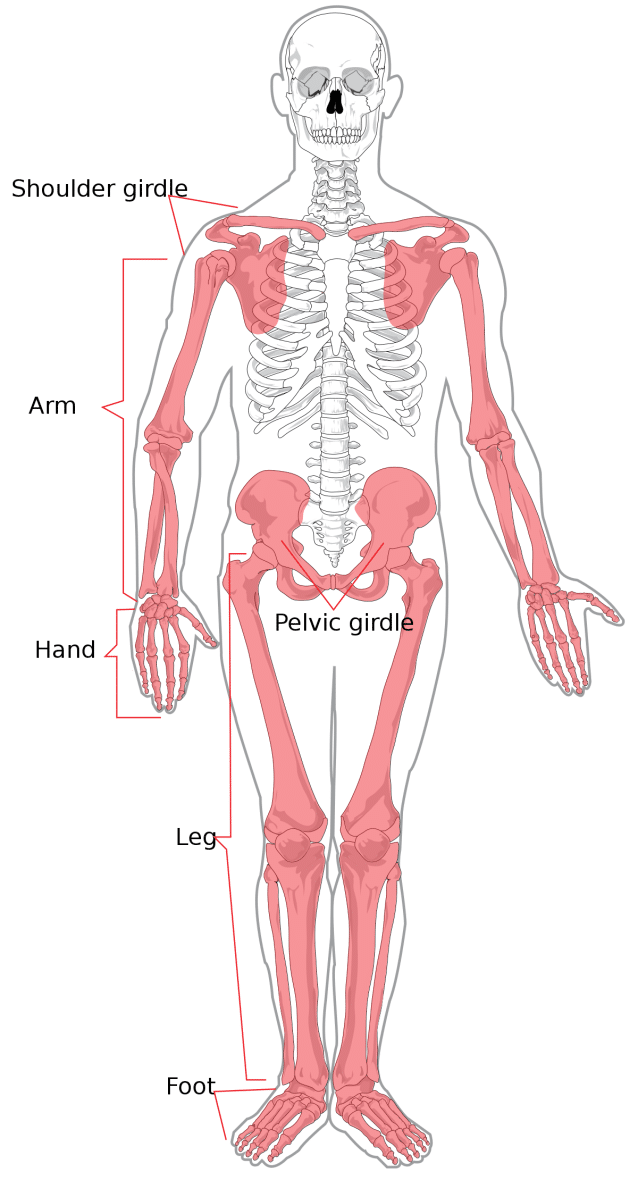
Functions of Appendicular Skeleton:
They constitute the movable pieces, the arms and the legs, that allow the body to move. Without the appendicular skeleton, the axial skeleton – the head, spinal columns and ribs- will not be able to move. The appendicular skeleton helps us in balancing our body, aids in locomotion, helps in moving our wrist, in gripping things with our hands, writing, eating and to do many more such activities.
Bone Health:
Bone health depends on our diet and physical exercise. Our diet should be balanced and include adequate calcium and vitamin D. They include milk, cheese, yogurt, sea food, leafy greens, legumes, almonds, dried figs, oranges etc. As a growing child, it is mandatory to follow a regimen as your bones are changing continuously and new bones are being made.

Sources of Calcium and Vitamin D
Check Point
Fill in the blanks:
- The place where two bones meet is called a _______.
- The number of bones present in our skull is ____.
- The human skeleton is divided into two major parts that are Axial skeleton and __________________ skeleton.
- The rib cage protects soft internal organs like ___________ and ______________.
- 99% of the body’s ___________ is held in our bones and teeth.
Answer Key
- Joint
- 22
- Appendicular
- Heart and lungs
- Calcium
Schedule a Free session to clear worksheet doubts
No credit card required, no obligation to purchase.
Just schedule a FREE Sessions to meet a tutor and get help on any topic you want!
Learn more about Scientific Method and other important topics with 7th Grade Science Tutoring at eTutorWorld. Our expert science tutors break down the topics through interactive one-to-one sessions. We also offer the advantage of customized lesson plans, flexible schedules and convenience of learning from home.
Pricing for Online Tutoring
| Tutoring Package | Validity | Grade (1-12), College |
|---|---|---|
| 5 sessions | 1 Month | $124 |
| 1 session | 1 Month | $25 |
| 10 sessions | 3 months | $239 |
| 15 sessions | 3 months | $354 |
| 20 sessions | 4 months | $449 |
| 50 sessions | 6 months | $1049 |
| 100 sessions | 12 months | $2049 |
5th Grade Free Worksheets
- Galaxies
- The Solar System
- Planets
- Structure of Earth
- Plate Tectonics
- Earthquakes
- Volcano and Folded Mountains
- Mountains and Oceans
- Rocks and Fossils
- The Water Cycle
- What Causes Weather Patterns?
- Types of Precipitation
- Climate
- Difference between Weather and Climate
- Impact of Environmental Changes on Humans and Other Organisms
- Plants also Adapt
- Body Systems
- Skeletal System
- Human Nervous System
- Circulatory System
- Respiratory System
- Reproductive System
- Digestive System
- Excretory System
- Atomic Theory
- States of Matter
- Mixtures
- Chemical and Physical Changes
- Types of Energy
- Energy Transformations
- What is Electricity?
- Properties of Electricity
- Uses of Electricity
- Electrical Circuits
- What is Force?
- Newton’s Laws of Motion
Image Credits:
- https://etc.usf.edu/clipart/44000/44014/44014_skeleton.htm
- https://kidshealth.org/en/kids/muscles.html
- https://en.wikipedia.org/wiki/Axial_skeleton
- https://en.wikipedia.org/wiki/File:Human_skull_no_text_no_color.svg
- https://en.wikipedia.org/wiki/Rib_cage
- https://en.wikipedia.org/wiki/Appendicular_skeleton
- https://w ww.nof.org/patients/treatment/calciumvitamin-d/


